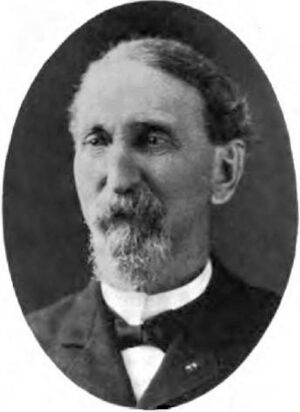Andrew L. Harris facts for kids
Quick facts for kids
Andrew Lintner Harris
|
|
|---|---|
 |
|
| 44th Governor of Ohio | |
| In office June 18, 1906 – January 11, 1909 |
|
| Preceded by | John M. Pattison |
| Succeeded by | Judson Harmon |
| 23rd and 29th Lieutenant Governor of Ohio | |
| In office January 8, 1906 – June 18, 1906 |
|
| Governor | John M. Pattison |
| Preceded by | Warren G. Harding |
| Succeeded by | Francis W. Treadway |
| In office January 11, 1892 – January 13, 1896 |
|
| Governor | William McKinley |
| Preceded by | William V. Marquis |
| Succeeded by | Asa W. Jones |
| Member of the Ohio Senate from the 3rd district |
|
| In office January 1, 1866 – January 5, 1868 |
|
| Preceded by | Lewis B. Gunckel |
| Succeeded by | Jonathan Kenney |
| Personal details | |
| Born | November 17, 1835 Milford Township, Ohio, U.S. |
| Died | September 13, 1915 (aged 79) Eaton, Ohio, U.S. |
| Resting place | Mound Hill Cemetery, Eaton, Ohio |
| Political party | Republican |
| Spouse | Caroline Conger |
| Children | 1 |
| Military service | |
| Allegiance | United States of America Union |
| Branch/service | United States Army Union Army |
| Rank | |
| Commands | 75th Ohio Infantry Regiment |
| Battles/wars | American Civil War |
Andrew Lintner Harris (born November 17, 1835 – died September 13, 1915) was an important leader from Ohio. People sometimes called him "The Farmer–Statesman." He was a hero in the American Civil War, especially at the Battle of Gettysburg. Later, he became the 44th governor of Ohio.
Contents
Andrew Harris: Early Life and Family
Andrew Harris was born on November 17, 1835, in Milford Township, Butler County, Ohio. He went to local schools and then studied at Miami University, finishing in 1860. After college, he joined the Union Army as a private. On October 17, 1865, he married Caroline Conger in West Florence, Ohio. They had one son together.
Military Service in the Civil War
Andrew Harris quickly moved up in the army. He became a colonel in the 75th Ohio Infantry Regiment. He fought in many battles with the Army of the Potomac.
Hero at Gettysburg
One of his most famous moments was at the Battle of Gettysburg on July 1, 1863. He bravely led his soldiers in a retreat through the busy streets. They then dug in on Cemetery Hill, a very important spot. The next day, Harris took command of a larger group of soldiers called a brigade. He helped stop strong attacks from a group called the "Louisiana Tigers." His actions helped protect Cemetery Hill for the Union Army.
Later War Service
Harris continued to lead troops throughout the war. After the war ended, he was given the honorary rank of brevet brigadier general. This was a special recognition for his service.
Andrew Harris: Political Career
After the war, Andrew Harris became a lawyer in 1865. He then served in several important government roles.
Early Political Roles
- He was a member of the Ohio State Senate from 1866 to 1870.
- From 1875 to 1882, he served as a judge in Preble County, Ohio.
Lieutenant Governor of Ohio
Harris was elected lieutenant governor of Ohio twice.
- First, in 1891 and 1893, he served with William McKinley, who later became president.
- He was elected again in 1905, serving with Governor John M. Pattison.
Governor of Ohio
In June 1906, Governor Pattison passed away. Andrew Harris, as the Lieutenant Governor, then became the 44th governor of Ohio. He served as governor from 1906 to 1909. During his time as governor, he signed a law that stopped companies from giving money to political campaigns. He also worked on a special commission about large businesses called trusts, under President McKinley.
Honors and Legacy
To honor Governor Andrew L. Harris, a part of U.S. Route 127 in Ohio was renamed the "Gov. Andrew L. Harris Bicentennial Roadway." This road runs between Hamilton and Eaton. In 2005, during the Milford Township Bicentennial, the roadway was officially dedicated.
Death
Andrew Harris passed away on September 13, 1915, due to heart problems. He is buried in Mound Hill Union Cemetery in Eaton, Ohio.

